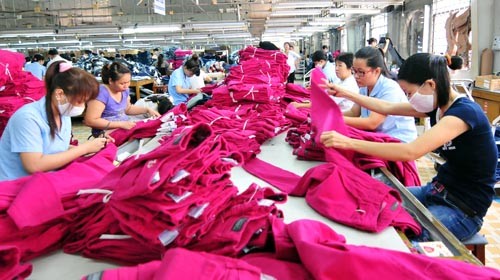(VOVworld) – Since the beginning of this year, Trade Ministers of countries involved in the Trans-Pacific Strategic Economic Partnership (TPP) Agreement have met to resolve disagreements aiming to put the agreement into effect later this year.
 |
The garment and textile sector will have opportunities from other TPP member countries
|
The Trans-Pacific Strategic Economic Partnership (TPP) Agreement is a free trade agreement with high standards. It’s considered a model agreement in the 21st century with the participation of Brunei, Australia, Canada, Chile, the US, Malaysia, Mexico, Japan, New Zealand, Peru, Singapore, and Vietnam. The TPP has concluded 19 rounds of official negotiations and has begun vital negotiations on opening the goods markets, rules of origin, government purchasing, state-owned enterprises, and e-commerce. Vietnam has completed negotiations with Japan and is pursuing negotiations with the Republic of Korea.
The TPP and opportunities for Vietnam
Joining the TPP will help Vietnam balance its trade relations with key markets and avoid over-dependence on a particular market. Vu Tien Loc, President of the Vietnam Chamber of Commerce and Industry, said that in order to effectively take advantage of the TPP, it’s necessary to review the economy’s strength, identify investment targets, and attract foreign investment. Loc said: “The TPP will impact Vietnam’s economy and its markets. It will influence institutional reorganizations and business environment reforms. The combined impacts will create new momentum for economic growth. We can seize opportunities if we have effective internal reform at the macro level and enterprises make an effort to improve their competitiveness.”
Tran Quoc Khanh, Deputy Minister of Industry and Trade and Head of the Government’s negotiation delegation on international economics and trade, said a visible opportunity for Vietnam from the TPP is to access the US market, the world’s biggest consumer market, at zero tariff. Besides the export benefits, Vietnamese-foreign invested service companies will enjoy a more transparent and predictable business environment when Vietnam implements its TPP commitments. Khanh said: “Our biggest opportunity is to restructure our import and export markets. We can open new foreign markets if the tax rate is 0%. It will be a strong driving force for Vietnamese exports in some markets and we can get involved in regional and international production chains. TPP accession will create favorable conditions for economic and growth model reform.”
Challenges of implementing TPP
Besides positive factors, the TPP will also create pressures on market openings and the competitiveness of Vietnamese enterprises. Some agricultural, industrial, and service sectors have not caught up with development demand. There are requirements of legal revisions and human resources.
For example, the garment and textile sector will have opportunities from other TPP member countries including the US, Japan, and Australia. Le Tien Truong, Deputy General Director of the Vietnam Garment and Textile Group, said the biggest obstacles are to meet the rules of origin and deal with the imbalanced development of the garment support industry. "This is an opportunity to expand markets with better conditions. There are challenges including how to meet the requirements of the agreement, markets, quality, quantity, and other non-tariff issues."
When joining the TPP, Vietnam should take appropriate steps to reform its economy and production. At present, Vietnam has to overcome negotiation challenges to ensure its national interests. Mr. Khanh again: "Pressure from competition is unavoidable. But we will try to control the competitive pressure under a certain roadmap. Vietnamese enterprises can overcome these difficulties because they have prepared in recent years."
Late this year, negotiations are scheduled to finish and TPP will come into effect. TPP member countries will comprise one of the world’s biggest trade areas, contribute 40% of the world’s GDP and one third of the global trade revenue.